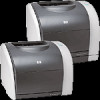HP Color LaserJet 2550 HP Color LaserJet 2550 series - User Guide - Page 75
Neutral Grays, Edge Control, RGB Color, Black Only, Color, Maximum, Normal, Light, Default, Vivid
 |
View all HP Color LaserJet 2550 manuals
Add to My Manuals
Save this manual to your list of manuals |
Page 75 highlights
Neutral Grays The Neutral Grays setting determines the method for creating gray colors that are used in text, graphics, and photographs. ● Black Only generates neutral colors (grays and black) by using only black toner. This option guarantees that neutral colors do not have a color cast. ● 4-Color generates neutral colors by combining all four colors of toner. This option produces smoother gradients and transitions to non-neutral colors. It also produces the darkest possible black. Edge Control The Edge Control setting determines how edges are rendered. Edge Control consists of two components: Adaptive Halftoning and Trapping. Adaptive Halftoning increases the edge sharpness. Trapping reduces the effect of color-plane misregistration by slightly overlapping the edges of adjacent objects. The following levels of edge control are available: ● Maximum provides the most trapping. Adaptive Halftoning is set to On. ● Normal provides the default trapping settings. Adaptive Halftoning is set to On. ● Light provides minimal trapping. Adaptive Halftoning is set to On. ● Off sets Trapping and Adaptive Halftoning to Off. RGB Color The RGB Color option determines how colors are rendered. ● Default interprets RGB color as sRGB, which is the accepted standard for many software companies and organizations, such as Microsoft and the World Wide Web Consortium. (See http://www.w3.org.) ● Vivid instructs the printer to increase the color saturation in the midtones. Less colorful objects are rendered more colorfully. This value is recommended for printing business graphics. ● Device sets the printer to print RGB data in raw device mode. To render photographs properly when this option is selected, you must manage color in the program in which you are working or in the operating system. ENWW Managing color options 65















